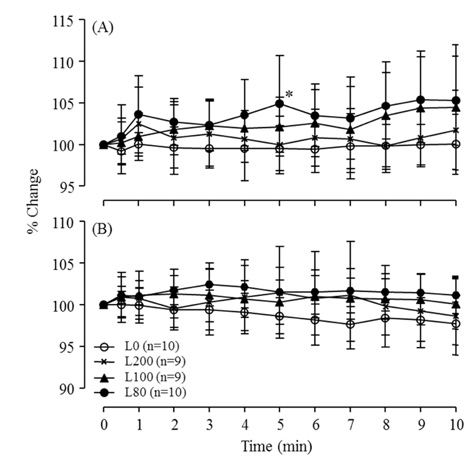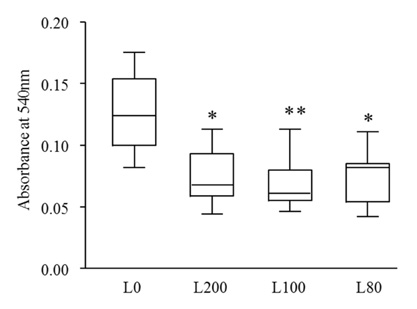J Dent Anesth Pain Med.
2018 Jun;18(3):143-149. 10.17245/jdapm.2018.18.3.143.
Comparative evaluation of the efficacy, safety, and hemostatic effect of 2% lidocaine with various concentrations of epinephrine
- Affiliations
-
- 1Department of Dental Anesthesiology, Seoul National University Dental Hospital, Seoul, Republic of Korea.
- 2Department of Dental Anesthesiology and Dental Research Institute, School of Dentistry, Seoul National University, Seoul, Republic of Korea. dentane@snu.ac.kr
- KMID: 2415178
- DOI: http://doi.org/10.17245/jdapm.2018.18.3.143
Abstract
- BACKGROUND
We evaluated the changes in mean arterial pressure (MAP) and heart rate (HR), and the anesthetic and hemostatic effects, after injection of 2% lidocaine containing various concentrations of epinephrine in rats and mice to determine the appropriate concentration of epinephrine in various anesthetic mixtures.
METHODS
Rats and mice were randomly allocated to experimental groups: 2% lidocaine without epinephrine (L0), 2% lidocaine with epinephrine 1:200,000 (L200), 1:100,000 (L100), and 1:80,000 (L80). Changes in MAP and HR after administration of the anesthetic mixture were evaluated using a physiological recording system in rats. Onset and duration of local anesthesia was evaluated by pricking the hind paw of mice. A spectrophotometric hemoglobin assay was used to quantify the hemostatic effect.
RESULTS
MAP increased in response to epinephrine in a dose-dependent manner; it was significantly higher in the L80 group than in the L0 group at 5 min post-administration. The HR was relatively lower in the L0 group than in the L80 group. The time required for onset of action was < 1 min in all evaluation groups. The duration of action and hemostatic effect of the local anesthetic were significantly better in the L200, L100, and L80 groups than in the L0 group.
CONCLUSION
L200 demonstrated relatively stable MAP and HR values with satisfactory efficacy and hemostatic effect. L200 might be a better local anesthetic for dental patients in terms of anesthetic efficacy and safety.
Keyword
MeSH Terms
Figure
Reference
-
1. Faccenda KA, Finucane BT. Complications of regional anaesthesia incidence and prevention. Drug Saf. 2001; 24:413–442.2. Hersh EV, Giannakopoulos H, Levin LM, Secreto S, Moore PA, Peterson C, et al. The pharmacokinetics and cardiovascular effects of high-dose articaine with 1:100,000 and 1:200,000 epinephrine. J Am Dent Assoc. 2006; 137:1562–1571.
Article3. Sano K. Vasoconstrictors in local anesthesia. Dental Diamond. 1988; 23:62–65.4. Bader JD, Bonito AJ, Shugars DA. A systematic review of cardiovascular effects of epinephrine on hypertensive dental patients. Oral Surg Oral Med Oral Pathol Oral Radiol Endod. 2002; 93:647–653.
Article5. Boonsiriseth K, Chaimanakarn S, Chewpreecha P, Nonpassopon N, Khanijou M, Ping B, et al. 4% lidocaine versus 4% articaine for inferior alveolar nerve block in impacted lower third molar surgery. J Dent Anesth Pain Med. 2017; 17:29–35.
Article6. Ping B, Kiattavorncharoen S, Durward C, Im P, Saengsirinavin C, Wongsirichat N. Hemodynamic changes associated with a novel concentration of lidocaine hcl for impacted lower third molar surgery. J Dent Anesth Pain Med. 2015; 15:121–128.
Article7. Dagher FB, Yared GM, Machtou P. An evaluation of 2% lidocaine with different concentrations of epinephrine for inferior alveolar nerve block. J Endod. 1997; 23:178–180.
Article8. Lee JY, Shin TJ, Choi JM, Seo KS, Kim HJ, Yoon TG, et al. Antinociceptive curcuminoid, kms4034, effects on inflammatory and neuropathic pain likely via modulating trpv1 in mice. Br J Anaesth. 2013; 111:667–672.
Article9. Daublander M, Muller R, Lipp MD. The incidence of complications associated with local anesthesia in dentistry. Anesth Prog. 1997; 44:132–141.10. Kaufman E, Goharian S, Katz Y. Adverse reactions triggered by dental local anesthetics: A clinical survey. Anesth Prog. 2000; 47:134–138.11. McLure HA, Rubin AP. Review of local anaesthetic agents. Minerva Anestesiol. 2005; 71:59–74.12. Sobanko JF, Miller CJ, Alster TS. Topical anesthetics for dermatologic procedures: A review. Dermatol Surg. 2012; 38:709–721.
Article13. Carvalho B, Fuller A, Brummel C, Cohen SE. Local infiltration of epinephrine-containing lidocaine with bicarbonate reduces superficial bleeding and pain during labor epidural catheter insertion: A randomized trial. Int J Obstet Anesth. 2007; 16:116–121.
Article14. Ghali S, Knox KR, Verbesey J, Scarpidis U, Izadi K, Ganchi PA. Effects of lidocaine and epinephrine on cutaneous blood flow. J Plast Reconstr Aesthet Surg. 2008; 61:1226–1231.
Article15. Serrera Figallo MA, Velazquez Cayon RT, Torres Lagares D, Corcuera Flores JR, Machuca Portillo G. Use of anesthetics associated to vasoconstrictors for dentistry in patients with cardiopathies. Review of the literature published in the last decade. J Clin Exp Dent. 2012; 4:e107–e111.
Article16. Neema C, Kapur S. Epinephrine toxicity: An avoidable fatal complication due to iatrogenic overdose. Sri Lankan J Aanesthesiol. 2013; 21:72–73.
Article17. Salonen M, Forssell H, Scheinin M. Local dental anaesthesia with lidocaine and adrenaline. Effects on plasma catecholamines, heart rate and blood pressure. Int J Oral Maxillofac Surg. 1988; 17:392–394.
Article18. Meechan JG, Parry G, Rattray DT, Thomason JM. Effects of dental local anaesthetics in cardiac transplant recipients. Br Dent J. 2002; 192:161–163.
Article19. Niwa H, Sugimura M, Satoh Y, Tanimoto A. Cardiovascular response to epinephrine-containing local anesthesia in patients with cardiovascular disease. Oral Surg Oral Med Oral Pathol Oral Radiol Endod. 2001; 92:610–616.
Article20. Knoll-Kohler E, Frie A, Becker J, Ohlendorf D. Changes in plasma epinephrine concentration after dental infiltration anesthesia with different doses of epinephrine. J Dent Res. 1989; 68:1098–1101.
Article21. Gerlach RF, Santos JETd, Escobar CAB. The use of epinephrine-containing anesthetic solutions in cardiac patients: A survey. Rev Odontol Univ São Paulo. 1998; 12:349–353.
Article22. Wakita R, Oono Y, Oogami S, Hayashi S, Umino M. The relation between epinephrine concentration and the anesthetic effect of lidocaine iontophoresis. Pain Pract. 2009; 9:115–121.
Article23. Haas DA. An update on local anesthetics in dentistry. J Can Dent Assoc. 2002; 68:546–551.24. Yagiela JA. Vasoconstrictor agents for local anesthesia. Anesth Prog. 1995; 42:116–120.25. Karm MH, Park FD, Kang M, Kim HJ, Kang JW, Kim S, et al. Comparison of the efficacy and safety of 2% lidocaine hcl with different epinephrine concentration for local anesthesia in participants undergoing surgical extraction of impacted mandibular third molars: A multicenter, randomized, double-blind, crossover, phase iv trial. Medicine. 2017; 96:e6753.
- Full Text Links
- Actions
-
Cited
- CITED
-
- Close
- Share
- Similar articles
-
- The Antimicrobial effects of Lidocaine and Epinephrine
- Effects of Added Epinephrine on Plasma Concentration of Lidocaine Following Epidural Anesthesia
- Plasma Concentrations of Lidocaine Associated with Caudal Anesthesia
- Serum Lidocaine and Mepivacaine Level during Axillary Brachial Plexus Block
- Teh Effect of Local anesthetic on Degeneration and Regeneration of the Experimentally Traumatized Striated Muscle




